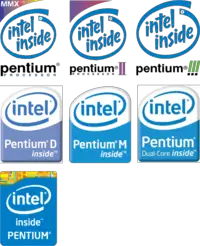| Line 103: | Line 103: | ||
== Architecture == | == Architecture == | ||
| + | {{empty section}} | ||
| + | |||
| + | == Design == | ||
{{empty section}} | {{empty section}} | ||
Revision as of 01:28, 21 March 2016
| Intel Pentium | |

| |
| Past and current logos | |
| Developer | Intel |
| Manufacturer | Intel |
| Type | microprocessors |
| Introduction | September, 1992 (announced) May, 1993 (launch) |
| Architecture | 32-bit superscalar implementation of IA-32 with SIMD |
| ISA | IA-32 |
| Word size | 32 bit 4 octets
8 nibbles |
| Process | 800 nm 0.8 μm , 600 nm8.0e-4 mm 0.6 μm , 350 nm6.0e-4 mm 0.35 μm , 250 nm3.5e-4 mm 0.25 μm , 180 nm2.5e-4 mm 0.18 μm , 130 nm1.8e-4 mm 0.13 μm , 90 nm1.3e-4 mm 0.09 μm , 65 nm9.0e-5 mm 0.065 μm , 45 nm6.5e-5 mm 0.045 μm , 32 nm4.5e-5 mm 0.032 μm , 22 nm3.2e-5 mm 0.022 μm , 14 nm2.2e-5 mm 0.014 μm
1.4e-5 mm |
| Technology | CMOS |
| Clock | 60 MHz-3.73 GHz |
| Socket | Socket 4, Socket 5, Socket 7, Socket 8, Socket 479, Socket 478, Socket 370, Socket M, Socket P, Socket T, Slot 1, MMC-1, MMC-2, Mini-Cartridge, PPGA-B615 |
Pentium is an extended family of x86 microprocessors developed by Intel since 1992.
Contents
History
Following Intel's previous microprocessor series (186, 286, 386, and 486), this family was set to become the 586. In an attempt to weed out the competition who were selling Intel-compatible clones, Intel filed to trademark the 586. Unfortunately, the generic numbering of the series caused its registration to be denied. In pursue after a fitting brand name they could trademark, Lexicon Branding suggested they consider a name ending in "-ium" as their research indicated pent- connoted strength and power (e.g. Pentagon). pent- is also similar to penta- meaning 5, denoting 5th generation x86. The -ium suffix connoted something scientific in nature (e.g. an element on the periodic table). The "Pentium" trademark was filed on July 2, 1992.
In 2014 Intel released the Pentium 20th Anniversary Edition commemorating the 20th anniversary of the Pentium family.
Timeline
Below is the timeline based on introductory date. Frequency represents the maximum frequency offered.
Architecture
| This section is empty; you can help add the missing info by editing this page. |
Design
| This section is empty; you can help add the missing info by editing this page. |
| designer | Intel + |
| first announced | September 1992 + |
| first launched | May 1993 + |
| full page name | intel/pentium + |
| instance of | microprocessor extended family + |
| instruction set architecture | IA-32 + |
| main designer | Intel + |
| manufacturer | Intel + |
| name | Intel Pentium + |
| process | 800 nm (0.8 μm, 8.0e-4 mm) +, 600 nm (0.6 μm, 6.0e-4 mm) +, 350 nm (0.35 μm, 3.5e-4 mm) +, 250 nm (0.25 μm, 2.5e-4 mm) +, 180 nm (0.18 μm, 1.8e-4 mm) +, 130 nm (0.13 μm, 1.3e-4 mm) +, 90 nm (0.09 μm, 9.0e-5 mm) +, 65 nm (0.065 μm, 6.5e-5 mm) +, 45 nm (0.045 μm, 4.5e-5 mm) +, 32 nm (0.032 μm, 3.2e-5 mm) +, 22 nm (0.022 μm, 2.2e-5 mm) + and 14 nm (0.014 μm, 1.4e-5 mm) + |
| socket | Socket 4 +, Socket 5 +, Socket 7 +, Socket 8 +, Socket 479 +, Socket 478 +, Socket 370 +, Socket M +, Socket P +, Socket T +, Slot 1 +, MMC-1 +, MMC-2 +, Mini-Cartridge + and PPGA-B615 + |
| technology | CMOS + |
| word size | 32 bit (4 octets, 8 nibbles) + |